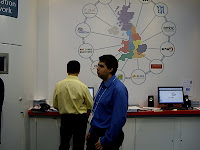
1. BJET- British Journal of Educational Technology
2. CAE - Computer Applications in Engineering Education
BJET- British Journal of Educational Technology
Edited by:
Nick Rushby, Print ISSN: 0007-1013, Online ISSN: 1467-8535
Frequency: Bi-monthly, ISI Journal Citation Reports® Ranking: 2009: Education & Educational Research: 32 / 139, Impact Factor: 1.255
- http://www.wiley.com/bw/journal.asp?ref=0007-1013&site=1
Educational technology in China_1094 541..548
Liu Meifeng, Lv Jinjiao and Kang Cui
Vol 41 No 4 2010 pages 541–548
Ref.: http://onlinelibrary.wiley.com/doi/10.1111/j.1467-8535.2010.01094.x/pdf

"Based on the above understanding, Liu (2003) put forward the position of educational technology in broad sense. She pointed out that there are three aspects of educational technology knowledge:
1. Knowledge about identifying the educational or instructional practical problem, trying to search for a basis, to utilise or to transfer science or technology theories and experiences related to teaching and learning. And then, through study, experiment and exploration, creatively forming the problem-solving principles, procedures, approaches or methods, skills or techniques and the requirement for related desirable resources (media, environments and corresponding support systems).
2. Knowledge about how to design, develop, utilise, manage and evaluate the related process and required resources for solving the problem above. Here the process involves a series of operations or activities directed at solving the problem; resources refer to the desirable various media, environment and corresponding support system required in the solution to the problem.
3. Knowledge about ideology, the application model and the procedure for the implementation of the systems approach and formative research based on action research. This knowledge is about methodology of educational technology instead of the specific method (for example, experiment, questionnaire), which directs educational technologists to think and solve the practical problems and forms the knowledge of educational technology (Liu, 2003, 2006). Regarding the relationship between the discipline of educational technology and other disciplines of the field of education addressed by Liu (2006), there are at least three modes of thinking in the field of education (Huang, 1998):
1. The philosophical mode of thinking is to reflect and research on ‘why education’ in the field of education: its purpose is to interpret the nature of education. This task has been undertaken by the discipline of educational philosophy.
2. The scientific mode of thinking refers to the way of thinking and research area of ‘what is education’ in the field of education: its purpose is to describe the law of education, explain educational phenomenon and predict the future of education. Those have been the mission of many disciplines of sciences of education, such as educational psychology, Educational sociology and so on.
3. The technological mode of thinking refers to the way of thinking and research area of ‘how to educate’ in the field of education. It aims at promoting educational goal achieved effectively and efficiently, based on the educational theories described by educational philosophy and sciences of education"
Ref.:http://onlinelibrary.wiley.com/doi/10.1111/j.1467-8535.2010.01095.x/pdf
The educational technology centre: A window to view the progress of Chinese ICT-based higher education (pages 642–659)
Rong Zhou and Baizhi Xie
"In China, after many years, the current status and challenges of e-learning development in higher education have been gradually understood. The educational technology centre (ECT) serves as the key unit to promote e-learning initiatives, but the performance of some centres still trails their foreign counterparts. Under such conditions, the project ‘Construction Model of the ETC in Chinese Universities and Colleges’ was conducted. An investigation of the e-learning performance of 70 ETCs was provided and the main problems were identified through quantitative analysis. Then, with the guidance of international standards, the ‘functional-level’ model coupled with some common strategies for its application was created as an innovative blueprint to help the ETCs towards excellence.
Today, Chinese ETCs are facing and will continuously face great challenges brought about by newly appearing technologies and pedagogies in post-secondary instruction. However, the standards and models directly guiding the ETC’s development remain mostly absent acrossmuch of China. Owing to insufficient understanding of their roles and tasks in conducting e-learning, some ECTs have fallen behind. Our project tries to fill the blanks relating to the relevant research and hopes that the implementation of the functional level model based on the investigation of 70 ETCs in Chinese universities will pave the way for the future success of all such centres."
CAE - Computer Applications in Engineering Education
Edited by: Magdy F. Iskander, Online ISSN: 1099-0542
- http://onlinelibrary.wiley.com/journal/10.1002/(ISSN)1099-0542
Ref.: http://onlinelibrary.wiley.com/doi/10.1002/cae.20264/pdf
June 2010, Volume 18, Issue 2 (pages 331–343)
On Examples of E-Education Environment for Distance Graduate Studies
By JONAS MOCKUS, Institute of Mathematics and Informatics, Akademijos 4, Vilnius LT-08663, Lithuania

"The traditional way of learning is based on textbooks and formal lectures. For recent results of information technologies and computer sciences a different approach is needed [1]. For scientific collaboration, the possibility of running software, developed by colleagues, on the Internet is essential. One can directly test the results of other researchers by running their software with different data. Therefore algorithms, software, and the results published in the scientific articles can be investigated independently.
This possibility is not yet widely used, but the potential appears great. We can test the software by running Java applets. The snapshots of graphical user interfaces are useful for testing the results, too. The snapshots help to make calculations exactly as authors intended. In open source software no clear boundaries between users and developers are defined. The software developed by a user often is applied by many others. Therefore open source software is an important tool for academic studies and scientific collaboration. For example, the Linux operating system is the result of Linus Torvalds graduate studies at the University of Helsinki [2]".
[1] J. Mockus, Investigation of examples of e-education
environment for scientific collaboration and distance
graduate studies, part 1, Informatica 17 (2006), 259_
278.
[2] L. Torvalds and D. Diamond, Just for fun: The story
of an accidental revolutionary, Harper Collins
Publishers, New York, 2002.
No comments:
Post a Comment